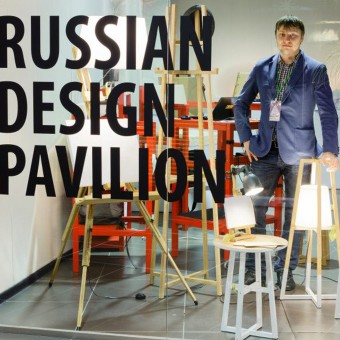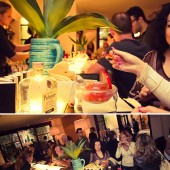
| THE AWARD |
| CATEGORIES |
| REGISTRATION |
| SUBMIT YOUR WORK |
| ENTRY INSTRUCTIONS |
| TERMS & CONDITIONS |
| PUBLICATIONS |
| DATES & FEES |
| METHODOLOGY |
| CONTACT |
| WINNERS |
| PRESS ROOM |
| GET INVOLVED |
| DESIGN PRIZE |
| DESIGN STORE |
| THE AWARD | JURY | CATEGORIES | REGISTRATION | PRESS | WINNERS | PUBLICATIONS | ENTRY INSTRUCTIONS |
Russian Design Pavilion Program of Design Events by Russian Design Pavilion |
Home > Winners > Design #32474 >Interview |
 |
|
FS: What is the main principle, idea and inspiration behind your design?
AM: Being design consultant and organizers, we are focused on the quality of our services: communication, meeting the clients needs, PR and mutual development of ourselves and our clients.
FS: What has been your main focus in designing this work? Especially what did you want to achieve?
AM: Our main focus was to make our project known in the world design society, to make professionals in design know about the existance of Russian designers and their potential. Fortunately, Western press and buyers started to show interest in our designers and our project is highly evaluated by Silver A'Design Award 2013-2014.
FS: What are your future plans for this award winning design?
AM: We are thinking of making this project more commercial as so far we were investing our skills and time in its promotion. So we are considering various options in terms of its development but on a new level.
FS: How long did it take you to design this particular concept?
AM: We have been working on RDP project and its exhibitions since 2012 and about 1,5 years on the RUB DESIGN book. Now we are promoting the book and posting in to the European producers and attract more attention to our designers and find the producers.
FS: Why did you design this particular concept? Was this design commissioned or did you decide to pursuit an inspiration?
AM: We were interested in international co-operation as the economy became global and we can recommend the best designers to the best world producers so everybody benefit from their performance and collaboration. It's funny, but even local productions don't know where and how to find good and professional designers or pay fair enough for their work as it is still considers as decorative one from time to time. Thus, we have studied the approaches of different countries in terms of design development and almost in all of the countries where design exists, it plays a significant role in economy, also it is supported by the governmental organizations. There are design centers, design councils that push the local design industry and creates favorable conditions for designers in their growth. Unfortunately, in Russia we still have the oil economy and production is not developed after Perestroika ruined it. That is why, design even does not exist as the economic sector, nor we have and body to promote Russian design abroad (only heavy or military industry and culture). So our idea was to start with some efforts like exhibitions and the book that we could afford ourselves in the conditions of no sponsorship.
FS: Is your design being produced or used by another company, or do you plan to sell or lease the production rights or do you intent to produce your work yourself?
AM: Our project is partly supported by other producers wishing to promote their products within Russian designers (clothes, accessories etc). Also, we are staring to attract the Russian producers of materials (for example, Expromt company which produces products from DuPont TM Corian. They use Russian designs to show the opportunities and qualities of their production and materials via exhibiting new designs. So we are aiming for further growth and new business contacts to make an independent project, alternative to a design center.
FS: What made you design this particular type of work?
AM: Our background in art and design curator work (Anastasia) and in international education consultancy in design field (Maria) forced us to make something useful and unique.
FS: Where there any other designs and/or designers that helped the influence the design of your work?
AM: We are influenced by the history of our country, big artists and engineers, by our culture and and heros. We would like today's Russia is known and respectful for its clever and creative minds, not only for its resources. Kalashnikov, Mendeleev, Lomonosov, Gagarin, Diaghilev are only the few to be proud of and to equal.
FS: Who is the target customer for his design?
AM: We are offering different services: education consultancy for students and professionals to improve the skills abroad in the leading design schools, then design promotion (exhibitions, presentations, books& catalogues, contests) - which connects design students, graduates, professionals with leading media sources for better recognition and with producers for possible cooperation.
FS: What sets this design apart from other similar or resembling concepts?
AM: We are the only so far who promotes Russian design on international level trying to put together PR in media, producers and designers, designers and distributors or the final buyers.
FS: How did you come up with the name for this design? What does it mean?
AM: Russian Design Pavilion aimed to promote Russian speaking designers regardless the place they live (can be in Russia, CIS countries or anywhere in the world). We also try to attract Russians living abroad to participate in our projects.
FS: What is the most unique aspect of your design?
AM: Our belief in its success.
FS: Who did you collaborate with for this design? Did you work with people with technical / specialized skills?
AM: We united our efforts (design curating and education consulting) and also collaborate with graphic designers (for creating images, brochures, book) and some assistance during exhibitions (stand assistants, photographers etc).
FS: What is the role of technology in this particular design?
AM: Our main technology is communication.
FS: Is your design influenced by data or analytical research in any way? What kind of research did you conduct for making this design?
AM: Yes, we studied international practices and made some research among design centers and councils and still keep on studying the best practices. It would be very helpful to pass the internship in some centers to learn more about their work.
FS: What are some of the challenges you faced during the design/realization of your concept?
AM: The main challenge is to create projects without any financial support and persuade clients that your idea will work and bring them results.
FS: How did you decide to submit your design to an international design competition?
AM: Some of our designers have this prestigious award and we learnt there is a nomination not only in product design but in design events so we decided to apply.
FS: What did you learn or how did you improve yourself during the designing of this work?
AM: Maria: I used to work as independent educational consultant and I have learnt that if you want to have bigger results you should try to trust people and give a part of work for outsourcing. Anastasia: Within the international projects i improved my organizational and communication skills, my work in partnership and in team of people by different cultural and professional background.
FS: Any other things you would like to cover that have not been covered in these questions?
AM: Well, we are looking for new business contacts, practices and opportunities for further development. We are open for international collaboration.
FS: Thank you for providing us with this opportunity to interview you.
A' Design Award and Competitions grants rights to press members and bloggers to use parts of this interview. This interview is provided as it is; DesignPRWire and A' Design Award and Competitions cannot be held responsible for the answers given by participating designers.
| SOCIAL |
| + Add to Likes / Favorites | Send to My Email | Comment | View Press-Release | Translations |




